Mark 9/28 to join us for this annual parade down Central AVE.
a.k.a. Route 66 or the Mother Road
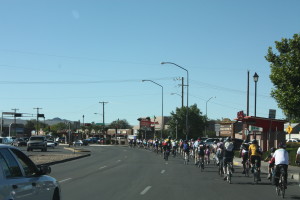
Ride with us! Add your voice to the call for traffic safety.
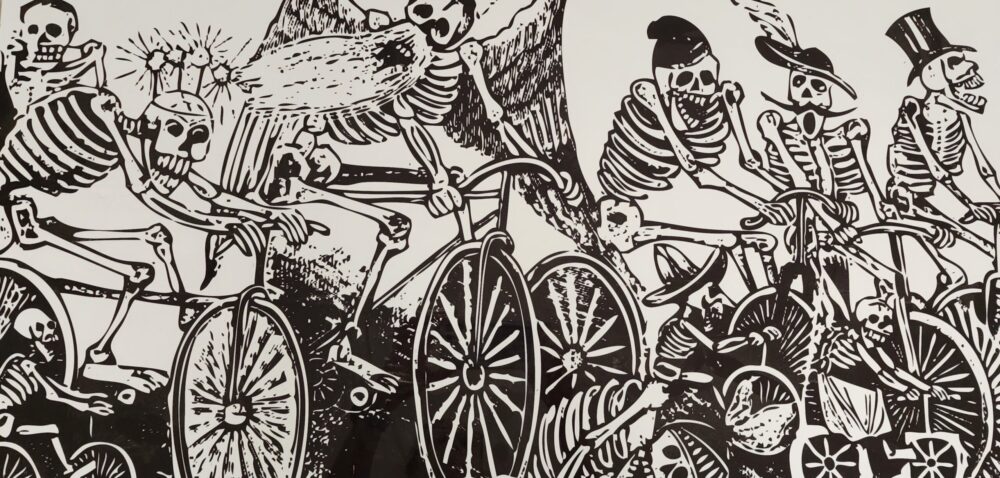
Mark 9/28 to join us for this annual parade down Central AVE.
a.k.a. Route 66 or the Mother Road

Ride with us! Add your voice to the call for traffic safety.
In April and again in June people using multi-use paths in Santa Fe that cross Rail Runner tracks rode out into the path of an oncoming train. These two individuals died. These multi-use paths have no safety arms or warning lights of their own.
On the other hand, people using city streets in Santa Fe while (typically) driving motor vehicles, encounter warning lights and arms specifically designed to stop them from driving into the path of the very same trains.
No one questions the presence of these safety devices on streets or highways. Departments of Transportation across the country realize that people need help in avoiding these collisions. Rail Runner/street crossings that don’t have arms or warning lights have been sites of motor vehicle/train crashes elsewhere in the State (between Los Lunas and Belen). Pedestrians have been killed at other unmarked crossings in Bernalillo County.
When considering multi-use paths, it isn’t accurate to think only cyclists use them. Path users routinely include children, elderly, disabled people, or those without the means or inclination to drive a motor vehicle. They also include those crazy enough to exercise outdoors – cyclists, runners, walkers, roller bladers, etc.
Are any of us really comfortable saying that this diversity of path users should be held to a higher personal standard for their safety at a track crossing compared to motor vehicle drivers? Said another way;
Why not protect all road and path users equally?
A website devoted to train track crossing safety posted A motorist is almost 20 times more likely to die in a crash involving a train than in a collision involving another motor vehicle. Comfortably, I’ll say that the likelihood of a path user dying from being hit by a train is even higher.
These crashes are always difficult to understand. What are people thinking? How can they not see or hear the train? Both the recent victims of bicycle/train collisions lived in Santa Fe. How could they not know about the trains!?
You might think that the closer we are to home the more familiar we are with potential hazards, like on-coming trains, and the better we would be at avoiding those hazards. If you do think that, think again. According to the National Highway Traffic Safety Administration (NHTSA) at U.S. DOT:
Three out of four crashes occur within 25 miles of a motorist’s home. Fifty percent of all crashes occur within five miles of home.
What this says to me is that people are, well, people. We make mistakes. We get comfortable with what is the most familiar and sometimes that lets us drop our guard. While this can be a good thing in an interpersonal relationship, it isn’t so good with respect to traffic safety.
As people, we are all quite susceptible to falling into that zoned out, less observant state of mind. I feel that equal protection from our own potential foibles is in order, no matter how we choose to be mobile on a given day.
I just can’t advocate for separate but unequal.
On Friday evening Duke City Wheelmen will place a ghost bike for Michael Wolff. He was hit while cycling on June 6, 2014 and passed away due to the injuries he sustained on June 14, 2014.
The ghost bike will be dedicated at 6:30 pm. This is the same time, and day of the week, that Michael was hit.
The family extends an open invitation to cyclists, and people concerned about traffic safety in general, to come to this ghost bike installation.
The driver of the car who hit Wolff fled the scene after the crash. Due to the diligence of Bernalillo County Sheriff’s Officers, 21 year-old Shilo Sap has been identified as the driver of the vehicle that hit Wolff. Sap has been arrested and charged with leaving the scene of an accident resulting in great bodily harm/fatality and careless driving.
Michael Wolff’s ghost bike will be the 30th that Duke City Wheelmen have placed in New Mexico for cyclists who have died while riding, from as long ago as 1984.
Directions:
The bike will be placed near a small memorial already at the crash site, in a location visible from the road. Sandia Trailer Sales & Service, 1435 HWY 333/Route 66, is a landmark close to where the crash occurred. The owners of East Mountain Dance, 1427 HWY 333/Route 66, have opened their parking lot to those driving to the dedication. To get to the site, take I-40 east bound from Albuquerque. Exit I-40 for NM-333 toward Sedillo, exit number 181. The ghost bike installation site is about 2.5 miles east of the I-40 exit #181.
At least three cyclists were pulled over while riding on the Tramway shoulder on March 25 and were warned (no citation) by the APD Officer that what they were doing was illegal. He told them to “look it up” when he was asked what ordinance he was enforcing.
“He said they were just giving out warnings now, and about to start handing out tickets.” This seems very reminiscent of what the cycling community went through a few years back….
City Council office (768-3100) provided the following info:
Ord. # O-11-46 was passed (8 in favor, 1 opposed) by City Council on 3/21/2011: Amending Sections 8-2-1-44(A) And 8-3-3-6 ROA 1994 To Remove The Prohibition On Bicycles Using Limited Access Roadways That Have Not Been Posted To Prohibit Bicycles
The ordinance was signed into law on April 5, 2011 by Mayor Berry.
If you care to find the ordinance, go to www.cabq.gov/council
(On left hand side choose “legislation”, then click on the link for “pending & adopted legislation” enter the ord #, the year (2011) and then click on “search”)
The Foothills APD station it turns out is the “home” station for Officer Riley (car L61) who pulled the cyclists over
This is minor to being shot by APD, but it is all part of the same problem. There is new information in the news that reveals problems with the training candidates receive. In addition to issues with the training, APD has lost so many senior officers, there is almost no one there for the long period of on-the-job training it takes for rookies to become good officers. With the Justice Department investigation ongoing & moral at rock bottom, recruiting quality candidates to the job is also a huge problem. Also, you can be sure that no officers are receiving the specialized training it takes to investigate a crash involving a motor vehicle and a bicycle or pedestrian.
All this in turn leads to a breakdown of police effectiveness across the board, from traffic safety to burglaries or other policing issues. These police shootings are the most outrageous, but everywhere you look APD is compromised. All of us are affected; this is not an issue just for the “homeless.”
For cyclists and pedestrians, the way that the Traffic Division is compromised leads to a lack of due diligence when investigating motor vehicle/bicycle or pedestrian crashes. This in turn will make it virtually impossible for anyone to be charged when there are severe crashes that result in great bodily harm or death. In addition, unlike a 1997/98 APD effort to actually enforce traffic laws today we have an “engineering” approach to bringing traffic under control.
This is a big issue. Most people are not aware of the extent of the problem within the Albuquerque Police Department. One way this all impacts cyclists and pedestrians is that the Traffic Division comprises the only people who have any chance at all to tell the stories of victims of severe crashes. Without training and being able to accurately document crash scene evidence, no accurate picture can be painted of what happened and victims have no voice.
I’m not anti-cop. What I want from APD is for the officers to be able to do (so much) more than pull the trigger.
Jennifer Buntz
Report from the GARTC meeting:
The members of the Greater Albuquerque Recreational Trails Committee are not any happier about the I-25/Paseo project’s bike/ped facilities. Or the “50 Mile Activity Loop” a.k.a. “50 Mile Bike Loop” (I have my own name for this particular plan, but it doesn’t belong here.)
Neither of these projects will improve the safety of cyclists or pedestrians. They don’t support the goals or objectives of the City of Albuquerque On-Street Bicycle Plan. They won’t make it any easier for people to choose to ride a bicycle instead of drive their vehicle. There will be no impact on the livability of Albuquerque. Both projects had/have potential, but with the current mentality of the decision makers in Albuquerque City Government, the potential is going to be lost.
Check back for more details.
*********************************
There are 3 important topics for discussion at the GARTC meeting Tuesday.
All these issues will have long term impact on the
SAFETY and QUALITY
of cycling in ALBUQUERQUE.
Meeting Agenda
**********************************************************************************************************
 Santa Cruz County Regional Transportation Commission Gets it!
Santa Cruz County Regional Transportation Commission Gets it!TORONTO gets it: “… we calculated that in 2006 alone the economic burden of congestion amounted to $3.3 billion and $2.7 billion in lost opportunities for economic expansion. These economic, social and environmental costs will more than double over the next quarter-century if not addressed.”
People in NORTH CARLIONA get it: “We need to start focusing on fostering a sustainable compact community with multi-modal transportation systems instead of focusing and catering to an environment built soley around using an automobile to go everywhere.”
Why: Because ABQ residents want our city streets that facilitate all forms of transportation.Albuquerque Journal. Monday, March 10, 2014. Page A4.
ATALE OF TWO WAYS TO TRAVEL: One got a ringing endorsement from officials last week, the other is fighting to get their attention tonight.
CITY GETS BRT GREEN LIGHT: First, the Federal Transit Administration has approved Albuquerque’s plans for Bus Rapid Transit along Central Avenue — and that can mean big federal matching dollars.
Unlike ABQ Ride, the bus system that is already a success on Central (that corridor accounts for 42 percent of all city riders), BRT would allow riders to buy tickets before they get on the bus, board quickly because the platforms are level with the floor of the vehicle, and travel in dedicated lanes with a driver who can communicate with traffic signals to reduce delays.
It’s like an e-ticket to your destination, whether that’s Old Town, Downtown, the University of New Mexico or Nob Hill.
According to the BRT Policy Center, BRT “service is frequent enough that passengers do not need a schedule” and “can operate at speeds nearly twice as fast as conventional buses and roughly equivalent to light rail, getting people quickly to their destination.”
Cleveland has BRT on its Euclid Avenue, a system Mayor Richard Berry has referred to often as a model. That city says its system runs passengers 24-7 down a 6.8-mile corridor to 58 stops including “the city’s cultural and educational institutions, medical and business centers, and all the mom and pop shops in between.”
The policy center says “BRT systems have capital and operating costs substantially lower than rail” and “can be developed incrementally, allowing systems to be installed over time as community needs and demands change.” And considering federal matching dollars could pick up a big chunk of the tab, a next-generation bus system seems to make more fiscal, transportation and economic development sense for Albuquerque taxpayers than the failed streetcar attempt of a prior administration.
A 2011 feasibility assessment would have Albuquerque’s BRT run on the Central median from 98th Street to Tramway Boulevard. The city says in a news release it plans to host public meetings over the next year “about BRT and the important part it can play in the vitality of our city’s future.”
CYCLISTS FLASH A YELLOW WARNING ON PASEO PLANS: Yet at the same time the city is working on alternatives to single-occupant motor vehicle traffic on Central, there’s a controversy coming to a head about ensuring cyclists and pedestrians have safe routes in the final Paseo del Norte/Interstate 25 rebuild.
Today, from 4:30 to 6:30 p.m. in Room 7096 of City Hall, it’s time to talk about what the state Department of Transportation has deemed “last design aspects.” Attendees are expected to include folks from the Greater Albuquerque Bicycle Advisory Committee, Duke City Wheelmen, Albuquerque’s Department of Municipal Development, as well as home office staff from Sens. Martin Heinrich and Tom Udall and Rep. Michelle Lujan Grisham.
It is important this missing segment of bike lanes be done in a smart manner — cyclists can already travel quickly and safely along Paseo from Coors to just west of Jefferson. There it gets challenging at best, with heavy truck traffic on El Pueblo, a busy Jefferson and — gulp — the interstate.
Cyclists will again present their concerns about the current proposal, which has changed from a bridge over the whole interchange to a route that Duke City Wheelmen President Jennifer Buntz describes as “a lot like running through a maze.”
And a dangerous one at that, with no barrier between the motorized vehicle frontage road and the bike path (should we order ghost bikes now and beat the rush?), cyclists expected to ride on sidewalks against traffic, with a guardrail on one side and a steep drop on the other (a pedestrian collision waiting to happen), an 8 percent grade on the bridge over the interstate (the steep pedestrian bridge over the river at Interstate 40 is just 5 percent), and no color or textural delineation of bike lanes from car lanes (just check out the vehicle tire marks in bike lanes around town to see why it’s needed).
Buntz’s point is not to bust the $93 million rebuild budget — she says the bike component “could be done much better within the financial constraints that are present” if the design-build team would allow a cycling perspective at the table.
“With the proximity of Railrunner/bus transit and the high number of employers in the I-25/Paseo area,” she explains, “there is a golden opportunity to support the last mile of a commuters journey with safe, direct and efficient bicycle and pedestrian facilities in this area.”
The city is busy gearing up the next generation of mass transit with an eye toward quite literally driving economic development. It would be great to see that kind of vision on Paseo as well.
 With several hundred people in attendance, many items were sold. The day, aided by Mimmo Espresso coffee, was a great opportunity to talk with old friends and make new ones. People were socializing, catching-up and making cycling plans for the spring.
With several hundred people in attendance, many items were sold. The day, aided by Mimmo Espresso coffee, was a great opportunity to talk with old friends and make new ones. People were socializing, catching-up and making cycling plans for the spring.
But we shouldn’t forget that the first purpose of putting this event on for DCW was to raise money for the work we do at Noon Day Ministries, fixing bikes and making them safer, for homeless or near-homeless bicycle riders.
To that end, we raised $440.00 from bicycle sales fees and table space rentals.
Big “Thank you” to some special supporters of the ESBS 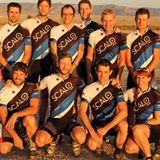
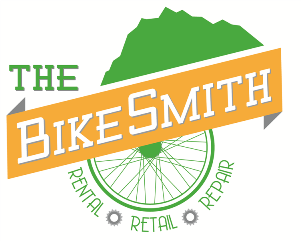 Scalo Veloce Cycling Team & Bike Smith
Scalo Veloce Cycling Team & Bike Smith
Thanks everyone who came out.
Mike Humphries, Trek Superstore Manager, was happy with the event too and we are already making plans for next year!
There will be a bike swap at Trek Superstore on Saturday February 1st. Tables will be available for $20.00 and you can sign-up by emailing me. There aren’t any other fees or service charges to sellers or buyers. Sign-up is only necessary so that we have enough tables for everyone. Doors open for sellers at 9 am and for buyers at 9:30, continuing till 1:00 pm.
This time of the year traffic always seems to get a little crazy. As I worked on freshing up the flowers on Michael Ryan’s ghost bike today, I noticed the traffic. Mike was riding in a bad place, but as we know, that doesn’t always matter.
Just stay alert out there, car, bike, truck, two feet, etc.
 Just think if Albuquerque had spent 1% of its traffic infrastructure investments on alternative means of transportation….
Just think if Albuquerque had spent 1% of its traffic infrastructure investments on alternative means of transportation….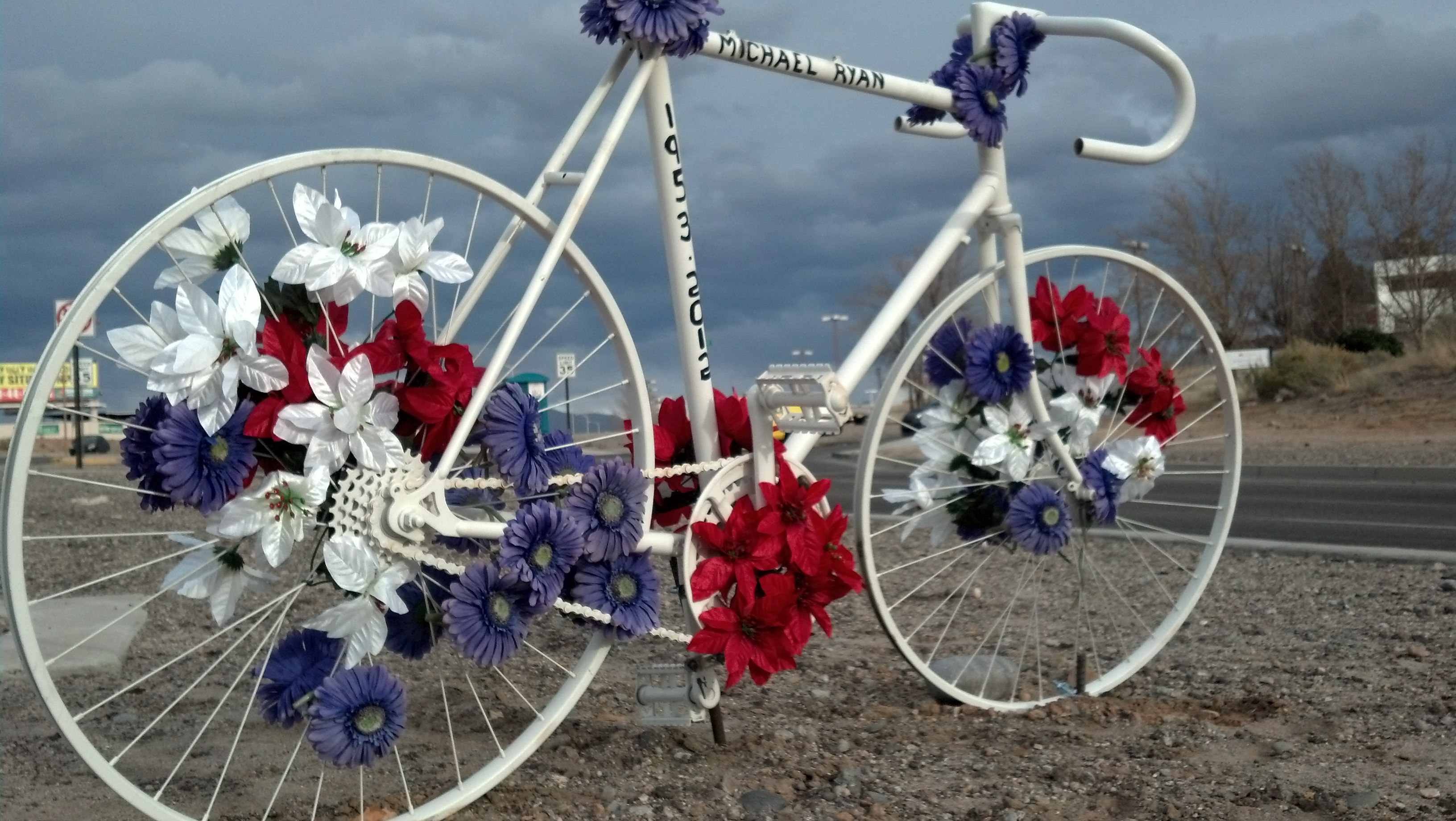 Michale Ryan
Michale Ryan
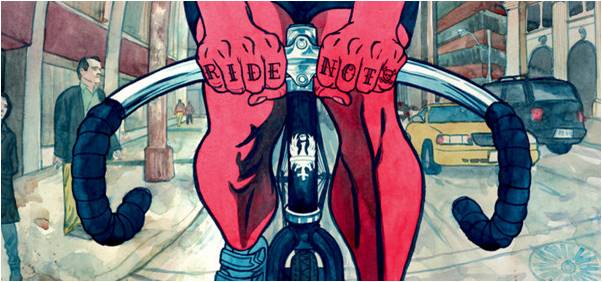
Cyclists, I think you know Duke City Wheelmen as a group that wants only the safest conditions possible for bicycling. With that in mind, consider the image below.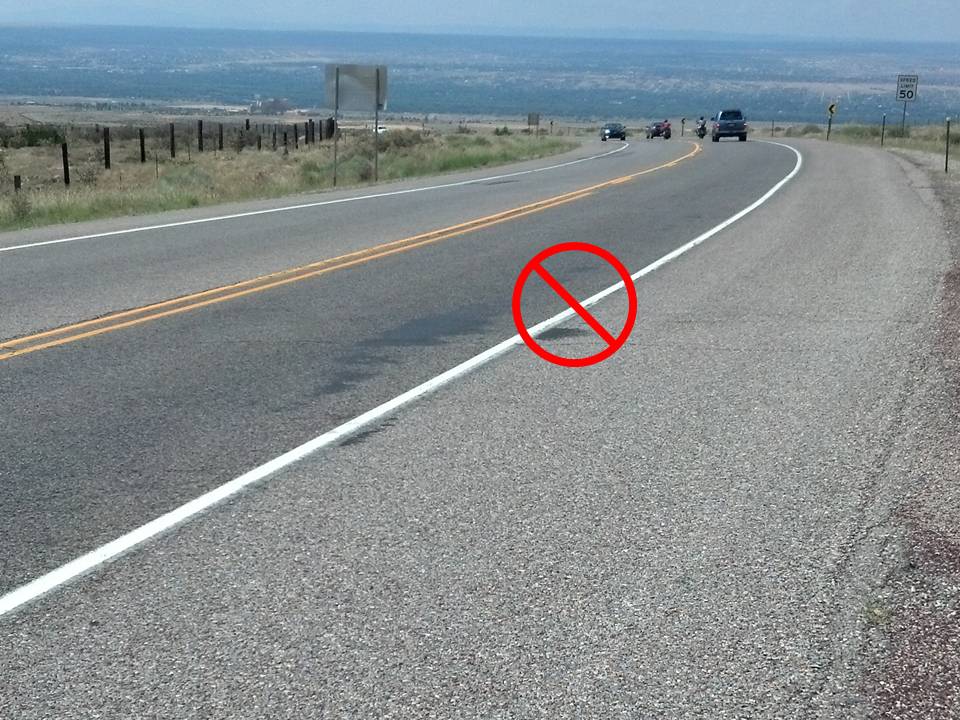
This is Tramway Boulevard NM Highway 556, on the westbound side. There is a six (6) to eight (8) foot shoulder up and down all of Tramway. And, as some of you know, NMDOT District 3 is repaving the entire shoulder of this east/west portion in an ongoing project (as of 10-27-2013).
With the goal of maximum safety in mind, PLEASE stop to consider your choice of where you ride on Tramway Boulevard. If you are one of the many cyclists magnetically drawn to the white line, I’m asking you to reconsider that choice.
Instead, I would suggest putting the width of this shoulder to use for safety.
Your safety.
Here, on a road like this, we can choose to have a buffer – space between ourselves and passing motor vehicles.
I know, you are just riding along (JRA) and not really thinking too much about your position on the road. You find your groove and it is as if you are magnetically drawn to the white line (even though you are riding a carbon bike).
What you aren’t thinking about is probably working against you.
One of the most frequent comments I get from motorists is their negative reaction to cyclists riding the white line. These folks get upset and angry about cyclists riding the white line, and frankly I do too.
I’m the first to defend a cyclists right to move left when there is an obstacle or the shoulder is too torn up to ride. There are many situations where we need to move left (see below).
But when this isn’t the case, THINK ABOUT WHAT YOU ARE DOING and move right. It is better for you and it is better for us all – because it avoids irritating motor vehicle drivers when we don’t have to.
I’m all for being seen and for taking the lane when necessary.
Bicycles are
vehicular road users
according to City of Albuquerque and New Mexico traffic code.
When you stop and think about it though, riding right when safely possible doesn’t diminish our status as vehicles on the road at all. It could be considered our way of making “Share The Road” a two way street (pun intended).
I send pictures like these to motorists who email me to complain about cyclists riding the white line, or moving left.
But on highways like Tramway, NM556, it is much harder to talk to motor vehicle drivers about what cyclists are doing. I don’t have a defense for the behavior and I don’t really think there is a good defense on a road like Tram.
If you would like to add your voice to the call to NMDOT to provide safe shoulders on ALL New Mexico Highways, for cyclists, pedestrians and any driver who needs to pull off the road, contact the New Mexico Department of Transportation
New Mexico State Cabinet Secretary, Designate Tom Church
P. O. Box 1149
Santa Fe, New Mexico 87504-1149
or
tom.church@state.nm.us
or at
(505) 827-5100